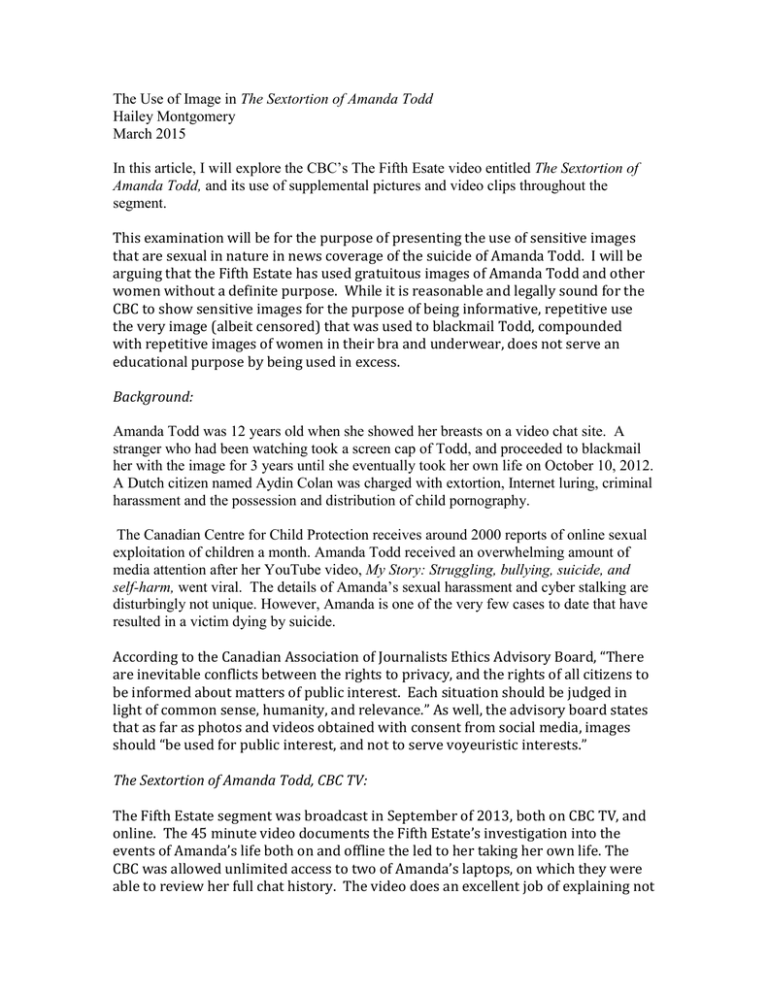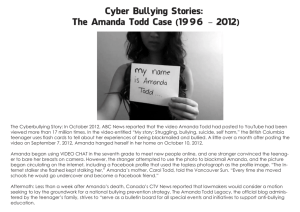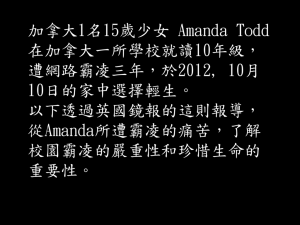
The Use of Image in The Sextortion of Amanda Todd
Hailey Montgomery
March 2015
In this article, I will explore the CBC’s The Fifth Esate video entitled The Sextortion of
Amanda Todd, and its use of supplemental pictures and video clips throughout the
segment.
This examination will be for the purpose of presenting the use of sensitive images
that are sexual in nature in news coverage of the suicide of Amanda Todd. I will be
arguing that the Fifth Estate has used gratuitous images of Amanda Todd and other
women without a definite purpose. While it is reasonable and legally sound for the
CBC to show sensitive images for the purpose of being informative, repetitive use
the very image (albeit censored) that was used to blackmail Todd, compounded
with repetitive images of women in their bra and underwear, does not serve an
educational purpose by being used in excess.
Background:
Amanda Todd was 12 years old when she showed her breasts on a video chat site. A
stranger who had been watching took a screen cap of Todd, and proceeded to blackmail
her with the image for 3 years until she eventually took her own life on October 10, 2012.
A Dutch citizen named Aydin Colan was charged with extortion, Internet luring, criminal
harassment and the possession and distribution of child pornography.
The Canadian Centre for Child Protection receives around 2000 reports of online sexual
exploitation of children a month. Amanda Todd received an overwhelming amount of
media attention after her YouTube video, My Story: Struggling, bullying, suicide, and
self-harm, went viral. The details of Amanda’s sexual harassment and cyber stalking are
disturbingly not unique. However, Amanda is one of the very few cases to date that have
resulted in a victim dying by suicide.
According to the Canadian Association of Journalists Ethics Advisory Board, “There
are inevitable conflicts between the rights to privacy, and the rights of all citizens to
be informed about matters of public interest. Each situation should be judged in
light of common sense, humanity, and relevance.” As well, the advisory board states
that as far as photos and videos obtained with consent from social media, images
should “be used for public interest, and not to serve voyeuristic interests.”
The Sextortion of Amanda Todd, CBC TV:
The Fifth Estate segment was broadcast in September of 2013, both on CBC TV, and
online. The 45 minute video documents the Fifth Estate’s investigation into the
events of Amanda’s life both on and offline the led to her taking her own life. The
CBC was allowed unlimited access to two of Amanda’s laptops, on which they were
able to review her full chat history. The video does an excellent job of explaining not
only the horrors of cyber bullying, but the emerging “new breed” of criminal called
“cappers”. Cappers coerce individuals to expose themselves or perform a sex act on
camera, and then proceed to blackmail them with this image in the hopes of
acquiring more images, or money. Todd was blackmailed for three years with one
image: her alleged offender capped a photo as she flashed her breasts on a video
chat room.
The Good:
The video successfully informs the public that internet safety is imperative. The fifth
estate emphasizes that young people are spending their lives in cyberspace, and that
it is becoming disturbingly common to be “sextorted”. The segment uses frequent
images of Todd which depict her as a regular girl who paid for an innocent mistake.
It is important for the public to know that what happened to Amanda could happen
to anyone.
Secondly, spreading awareness of teen suicide following cyber bullying, cyber
stalking, and exploitation, aids in the attempt to eliminate the stigma of this everprevalent mental health issue. Photos and videos of Amanda’s YouTube video, My
Story, appeal to our emotions.
Finally, this broadcast spends time profiling, and showing images of, offenders
responsible for the crimes in question. Time is spent on publically condoning the
offenders actions, allowing the CBC to spend less time focusing on the “mistakes” of
the victims.
The Bad:
Firstly, The Sextortion of Amanda Todd alternates between photos of Amanda, and
clips of other young women in different states of undress. Photographs of Amanda
in the first half of the program show her smiling with friends or family, posing for a
school, or playing on her suburban street. 12 minutes into the segment, the fifth
estate presents the photograph of Todd exposing her breasts on webcam, which was
used to blackmail her, for 10 seconds The photo is shown five more times
throughout the video.
Fifth Estate reporter Mark Kelly, points to the picture, and asks Carol Todd, “What
do you think when you look at this picture?” Carol Todd replies, “I want to know
who’s on the other side, taking the picture.”
This story is essentially about this photograph of Amanda, and it is reasonable that
the CBC would want the public to understand the nature of the image. However, it’s
repetitive use does not serve any obvious purpose, except for shock value. In a story
about the exploitation of a young girl, it seems contradictory to rebroadcast this
image excessively for the sake of ratings. The photo seems to serve the narrative of a
“good girl gone wrong” that the fifth estate is trying to tell.
Secondly, on 20 different instances throughout this broadcast, video and pictures
are shown of different women posing or performing on webcam. Each woman
shown is shown in her bra and/or underwear, or is naked with her breasts and/or
vagina blurred out. The women are either posing or dancing for the camera. A
number of clips include a close up of a woman’s breasts or her underwear.
We are never told who these women are, their age, or from which site their images
were obtained by the Fifth Estate. If the purpose of these photos’ inclusion was to be
informative, some context or information would make the images more relevant. In
a video that warns that these crimes are becoming extremely commonplace, it
would be most effective to include images that reflective the entire demographic of
young people that could be affected (young girls, and boys, of every race and size are
exploited online).
Not unlike the photograph of Amanda, these images were used very frequently
throughout the video. Their repetition, and duration on screen do not serve a
definite purpose. These images are provocative, and therefore draw in viewers. The
media tends to use women’s bodies as a tool for promotion – a trend which has been
shown to have endless negative consequences. In this way, a woman’s body is being
exploited to promote a video segment which is itself condemning sexual
exploitation.
Articles posted on www.cbc.ca regarding Amanda Todd only include photographs of
Amanda fully clothed. Only video coverage on the CBC uses the image of Amanda in
which she flashes her breasts on webcam.
Another Cases of Sextortion:
Daniel Perry, Fife, Scotland
Perry was 17 years old when he masturbated on camera for somebody who he thought
was an “attractive young woman.” Perry was recorded, and the offender threatened to
share this footage unless Perry paid a large sum of money. BBC Scotland is calling
Daniel’s case the worst of its kind in the UK’s history; 184 similar cases have been
brought to the attention of Scotland’s Child Exploitation and Online Protection (CEOP)
center, but Daniel’s is the first to have resulted in an individual taking their own life.
Daniel died in July of 2013.
A web search of Daniel Perry brings up few results. The most extensive coverage is by
BBC Scotland – the network has posted 5 different articles online. The videos
accompanying these articles are short, and use simple slideshows as background image.
The only photos of Daniel that are used show him smiling at the camera, dressed
casually. The BBC News Scotland article entitled Philippine arrests in Fife teen Daniel
Perry case is accompanied by a one-and-a-half minute long video, which follows Interpol
and Scottish police officers to Manila, the site of the online blackmail syndicate that
blackmailed Daniel. The images in Manila show the accused offenders, and the space
from which they operated. No images were shown that were sexual in nature.
Conclusion
This article has been for the purpose of discussing the use of video and pictures in the
Fifth Estate special The Sextortion of Amanda Todd. I argue that the photos and videos
that the segment selects are gratuitously sexual, and cross the line from informative to
sensational. While the public’s right to know and freedom of information is extremely
important, I believe that the media following this tragic story could have been handled
more delicately. The images of Amanda Todd, and the images of various sexualized
pictures of different women, are being over used to garner attention, and to suggest a
change in Amanda Todd’s character.
In the final moments of The Sextortion of Amanda Todd, Fifth Estate reporter Mark Kelly
asks Amanda Todd’s mother “what is the final image of [Amanda] that you would like
everyone to remember?” “Her singing,” Carol replied.




